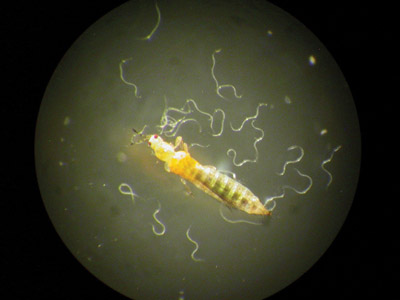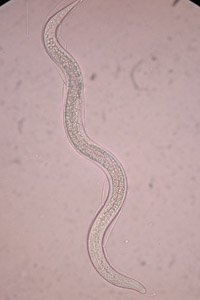
Insect pathogenic nematodes are finding an increasingly important place
in the pest management programs of many greenhouse growers. Available
and recommended for many years to control fungus gnats, they have
recently also been used as part of a pest management program for thrips.
Graeme Murphy and Dr. Michael Brownbridge
Opportunities to successfully use them as part of such a strategy have increased considerably in past decade
Insect pathogenic nematodes are finding an increasingly important place in the pest management programs of many greenhouse growers. Available and recommended for many years to control fungus gnats, they have recently also been used as part of a pest management program for thrips. Evidence suggests they may also contribute to the control of other pests such as leaf miners.
 |
| Thrips with nematodes. Photo courtesy Dr. Rose Buitenhuis, VRIC |
Nematodes enter an insect through various body openings (mouth, anus, and breathing holes called spiracles). Bacteria that live in the nematode’s gut are released into the insect where they multiply and eventually cause the insect’s death by releasing toxins and enzymes that break down the internal tissues. In turn, the nematodes feed on the resulting “soup,” mature and reproduce. Under natural conditions, infective stages will emerge from the dead insect over time.
FIRST TRIALS AGAINST THRIPS BEGAN WITH CUT MUMS IN THE ’90s
For fungus gnat control, nematodes are targeted against the larval stages and applied to the growing medium as a drench or sprench. The first evidence that nematodes could also infect thrips came in the late 1990s from the U.K., where cut chrysanthemum growers who applied nematodes weekly as a foliar spray, noted a reduction in their thrips populations. More recent work in Canada (Dr. Rose Buitenhuis), the U.K. (Jude Bennison) and Germany (Lemma Ebssa) showed that soil-dwelling stages of thrips (especially the pupal stages) were highly susceptible to several species of nematodes, and particularly to Steinernema feltiae. Mobile life stages on the plant (adults and larvae) appear to be less susceptible to attack. Thrips control noted in commercial crops probably occurred as a result of overspray and run-off into the soil after spraying.
 |
|
| A closeup of a nematode. Photo courtesy Julie Graesch, Becker Underwood |
Some leafminer control has also been obtained by Ontario growers in chrysanthemum crops when regular foliar sprays have been applied. In greenhouses where nematode treatments have been made, up to 50 per cent of leafminer larvae still in mines were found to have been killed or infected. However, nematodes are very susceptible to UV light and desiccation, so it is important that foliar sprays are applied in the evening (or on dull cloudy days with shadecloth drawn) so that the foliage remains wet for several hours. Nematodes can then enter the mines (presumably though wound sites made by the leafminer adult, or through cracks in the mine surface) where they will seek out a leafminer host, using chemicals produced by the host to locate its whereabouts.
U OF GUELPH RESEARCHING DIP TREATMENTS FOR CUTTINGS
Nematodes are also being evaluated in a graduate project at the University of Guelph by Wendy Romero, who is investigating them (among a number of other treatments) as a dip treatment for cuttings before planting in the greenhouse, to disinfest them of pests such as thrips and whiteflies.
So, how do we get the most from nematode applications? It is important to understand that nematodes are living organisms, and although they are applied using technology that growers are familiar with for pesticide applications, (e.g., hydraulic sprayers, injectors) that is where the similarities end. In discussions with Julie Graesch at Becker Underwood (a major producer of insect pathogenic nematodes), she emphasized three important points.
- Firstly, although they are applied in water, nematodes are not aquatic animals and therefore they need extra care while in stock and tank solutions, so adequate aeration of the nematode suspension during application is important. This can be done either mechanically or with an aeration pump. For reasons below the second of these is preferable.
- Secondly, nematodes are not the greatest swimmers in the world and settle out in the spray tank quite quickly. Trials by Becker Underwood showed them settling at a rate of 1 cm/minute. So, if left to their own devices, within a fairly short period of time they will be simply sediment at the bottom of the spray tank. While mechanical mixing will keep the nematodes in circulation, it will also heat the water to some extent and could damage the nematodes if left for too long. So a pump, such as a commercial pond air pump (or a fish tank bubbler for small volumes), will perform the dual function of keeping the nematodes suspended and providing them with oxygen.
- Finally, the suspension in the spray tank should be kept cool and applied as soon as possible after mixing. This is especially important during the warmer months. According to Graesch, nematodes have a limited amount of energy, so the longer they are kept before spraying and the warmer the tank water, the more quickly those energy reserves will be used up. Weaker nematodes are less robust during and after application, and less able to search for and infect a susceptible host.
RECOMMENDATIONS CALL FOR THEM TO BE USED IMMEDIATELY
Under ideal conditions (cool, well-mixed and aerated), nematodes in a spray tank should be able to survive for a few hours. But because no one except the grower has control over these conditions, the recommendations are to apply them as soon as possible. It should also be noted that any screens (50 mesh or finer) in the spray lines should be removed so that the nematodes can pass through unimpeded and undamaged and spray pressure should be kept below 300 psi.
As with any other biological, nematodes are best used in a preventive rather than a curative manner, so using them in conjunction with other IPM practices is essential to ensure applications are made at the most appropriate time. Becker Underwood also has extensive information on the compatibility of nematodes with various crop protection materials. If you plan on tank mixing to apply chemical insecticides or fungicides at the same time as nematodes, check the website http://www.beckerunderwood.com/en/nematodes for more information before you start.
Opportunities to successfully use nematodes as part of a pest management strategy have increased considerably in the past decade, with evidence of activity against new pests and potentially new ways of applying them. However, you may get inconsistent results if they are not treated as they should be. Think about the success you have had with using nematodes. If it has been less than you would like, perhaps they just need a little more pampering. ■
Graeme Murphy is the greenhouse floriculture IPM specialist with the Ontario Ministry of Agriculture, Food and Rural Affairs at Vineland.
• 905-562-4141, ext. 106, or graeme. murphy@ontario.ca.
Dr. Michael Brownbridge is the research director in charge of Horticulture Production at the Vineland Research and Innovation Centre.
Print this page